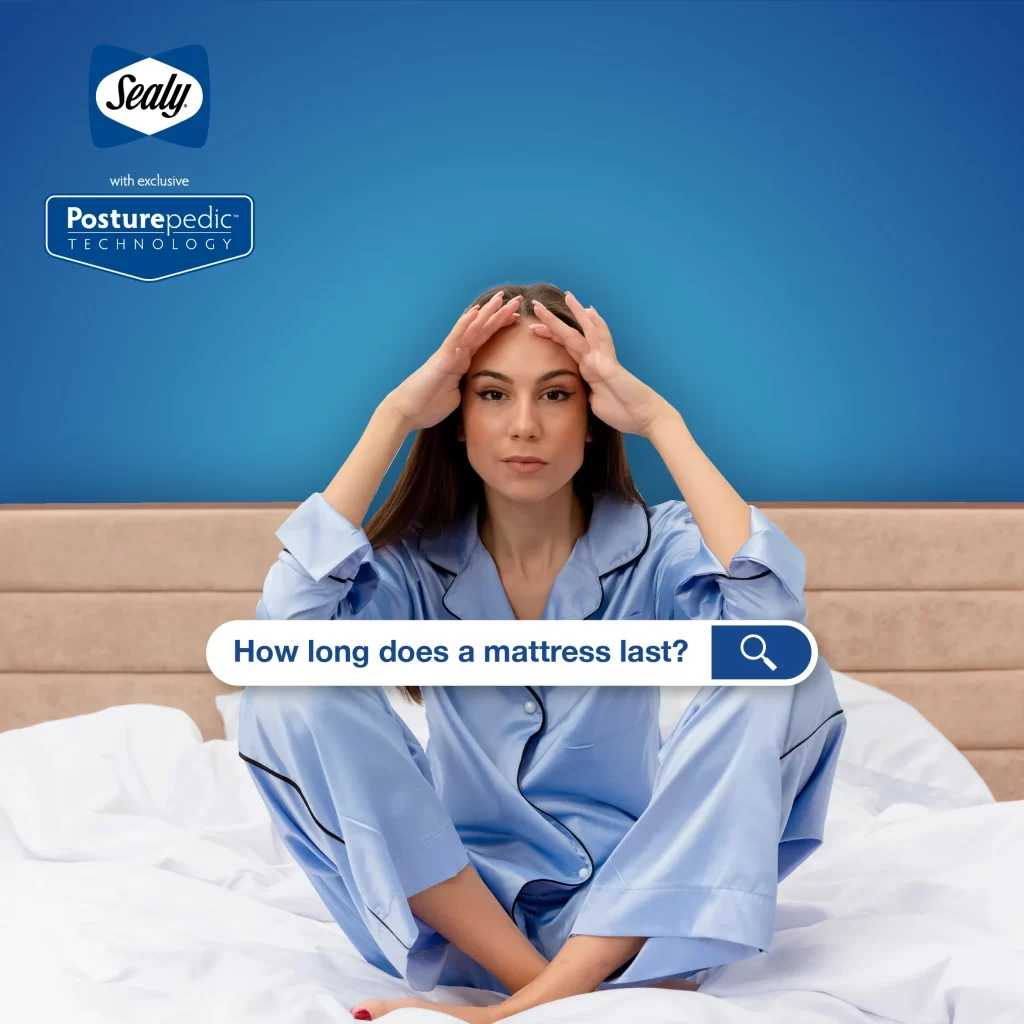Most mattresses should last between 7 to 10 years. This timeframe depends on the way the
mattress is made, handled, and used. Everything from manufacturing quality and
craftsmanship to the size and weight of the sleeper can have an impact on the longevity of the
mattress.
As one of South Africa’s oldest and most-loved bed brands, we often receive messages from
our fans telling us they’ve been sleeping on the same Sealy bed for the past 20 years or more.
It’s a testament to the good quality of a Sealy bed, but there are many factors that dictate
when a bed should be replaced.
The most important factor is how your body feels after a night in the bed. A study published in
the Journal of Chiropractic Medicine found that participants’ sleep quality improved when they
replaced their bed. If you spend 1/3 of your life in bed, that means by the time your bed is nine
years old, you’ve spent an average of three years lying on the same mattress. So, while your
mattress might seem to be in good shape, and it might even still be covered by your warranty,
the bed might not be providing the same comfort it initially did.
Sealy is dedicated to sleep research, so if your bed is almost a decade old, there’s a good
chance that you could be missing out on the latest sleep technology used in our newer
mattresses.
When to replace your mattress
All Sealy South Africa mattresses are made with a combination of our patented inner springs
and foam, and each bed comes with a warranty of between 9 and 12 years. Below we list the
suggested lifespan of different types of mattresses, with a reminder that it ultimately depends
on the use and quality of the mattress.
MATTRESS TYPE LIFESPAN
| Foam 5-7 years | Hybrid 6-10 years |
| Latex 6-10 years | Innerspring 7-10 years |
| Memory foam 10-15 years | Natural latex 10-20 years |
Latex
There are several variations of latex mattresses on the market. These beds tend to be heavier
and may trap heat throughout the night. Their lifespan depends on the type and quality of
latex the manufacturer has used.
Natural latex is made of rubber tree sap and is often blended with cotton or wool. Popular for its
hypoallergenic properties, a natural latex bed can last nearly 20 years if cared for
properly. Synthetic latex is typically more affordable and may suit those with latex allergies.
However, synthetic latex mattresses are less durable with a lifespan of approximately 6–10
years.
la Difference by Sealy is built with our Dual-flex hybrid foam, which seamlessly fuses the
resilience of latex foam with the pressure-reducing properties of memory foam. The la
difference combines our Dual-flex hybrid foam with our exclusive DSX Sense and Respond
Spring System, and a wool filling for luxurious comfort.
Foam
Foam mattresses are increasingly popular due to their lightweight construction and the ease
with which they may be rolled up and shipped. Though soft to the touch, many foam beds lack
sufficient back support. Much like latex, foam mattresses vary significantly in terms of their
materials and corresponding quality.
Memory foam mattresses can last 10-15 years, especially if they are made with high-density
materials and maintained well. However, low-density foams will only last around 5–7 years.
The lower the density of foam, the quicker it will sag and deteriorate under pressure.
Hybrid
As their name suggests, hybrid beds are a combination of other mattress types. Traditionally,
they feature foam or latex layers with springs. At face value, hybrid mattresses offer the best
of both worlds in terms of comfort and support; however, this is dependent on the quality of
materials and the kinds of springs used.
The Sealy Hybrid collection is handmade with our exclusive body sense pocket system and our
CoolSmart Gel Memory foam layer.
Innerspring
Innerspring mattresses feature a system of coils or springs that distribute weight across the
surface and support the body. If they are made with high-quality materials and cared for
appropriately, innerspring mattresses may last up to 10 years or more.
Not all innerspring beds are created equal, with some spring types wearing out significantly
faster than others. Sealy Posturepedic mattresses feature our patented network of coils that
sense and respond to your body’s movement while you sleep.
Factors influencing mattress lifespan
The lifespan of a mattress depends on:
• Materials and mattress type
• Body weight and sleep positions
• Chosen bed base
• Care and cleaning
Though they vary widely across the market, materials and construction methods are one of the
key factors influencing longevity and durability. If you are looking for a bed to last at least 10 or
more years, aim for high-density foams, latex, and/or pocketed springs. Higher quality
materials are often reflected in the price but be sure to check the specifications of the bed you
wish to purchase.
In addition, to build quality and materials, mattress lifespan is impacted by the way it is used
and cared for in the home. Your body weight and sleeping position may impact the materials;
for example, if you are a side sleeper, the cushioning around your hips and shoulders is likely
to wear faster than it would in other areas. This is especially the case if the mattress is never
rotated, or if the bed base is not supportive enough. Poor cleaning methods and a lack of care
may also reduce the longevity of your bed.
The top 7 signs you need a new bed
1) Your mattress is more than seven years old. As explained above, this is a general
guideline. Most Sealy mattresses easily last longer than 10 years.
2) If you wake up feeling tired with aches and pains, it could mean your mattress is no
longer supporting your body the way it should.
3) The bed is making more noise than usual – the springs are squeaking, or the bed’s
foundation is creaking.
4) There are visible signs of wear and tear, like a spring sticking out of the mattress.
5) There is noticeable sag in the middle of the bed. We call it ‘taco bed’, and it causes you
to roll into the middle of the bed.
6) Your allergies are worse than normal. You shed skin cells during the night and dust
mites feed on them. Dust mites cause allergies.
7) Your life circumstances have changed. Maybe you share a bed with a partner now, or
your kids sleep with you, or you have ailments you never had before. A lot can happen
in 10 years, so make sure your bed can support your healthy sleep during this time.
How to care for a mattress to last longer
Start by checking the care instructions. The manufacturer or retailer may have specific
timelines and methods regarding mattress care and maintenance. Here at Sealy, we
recommend the below steps to getting the most out of your investment:
• Regularly rotate. To get even wear across the entire sleep surface, you should rotate
your mattress on a regular basis. Not all types can be flipped over; Sealy mattresses
are not designed to be flipped or slept on both sides. Instead, spin the mattress 180
degrees, using the handles to assist with placement.
• Keep your bed clean by using a mattress protector. In addition, lightly vacuum the
surface regularly, treat spills and stains as soon as possible, avoid harsh chemicals or
detergents, and avoid scrubbing the fabric.
• Use an appropriate bed base. Slat bases may promote mattress sagging. Sealy bases
are designed to work with your mattress by absorbing stress and boosting support. A
Sealy base will help to withstand wear and tear to the highest degree over the life of
your warranty.







